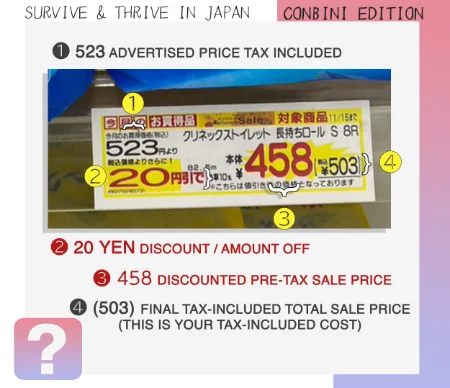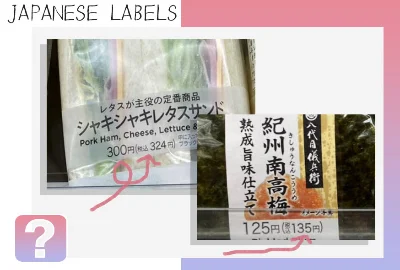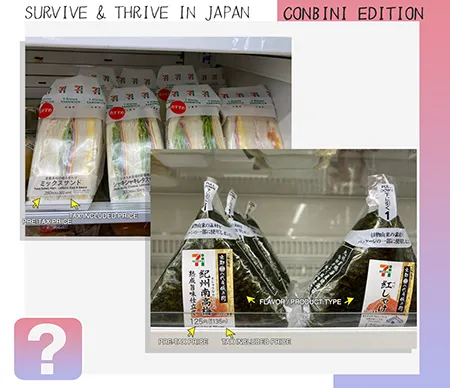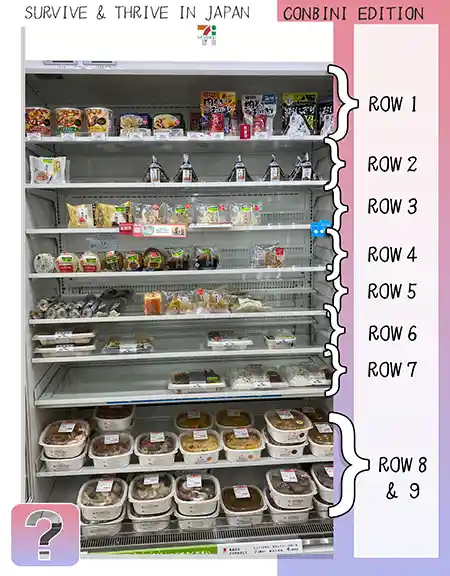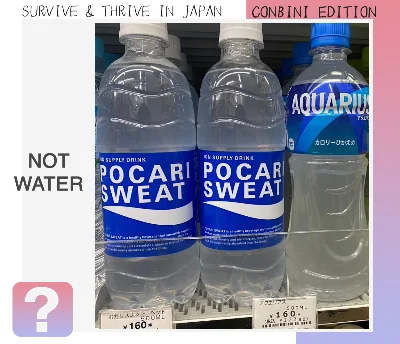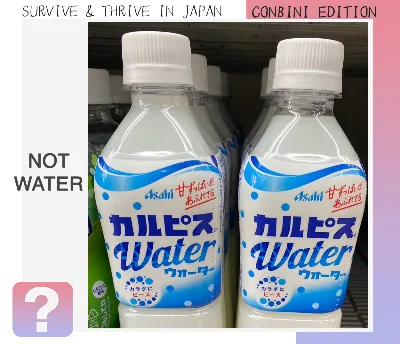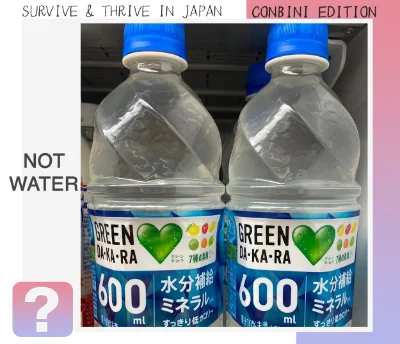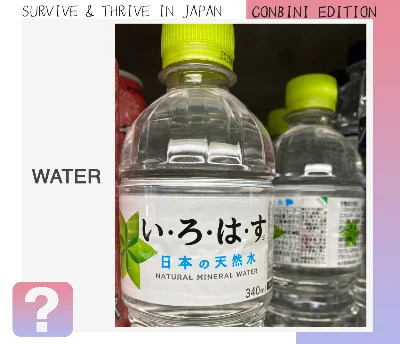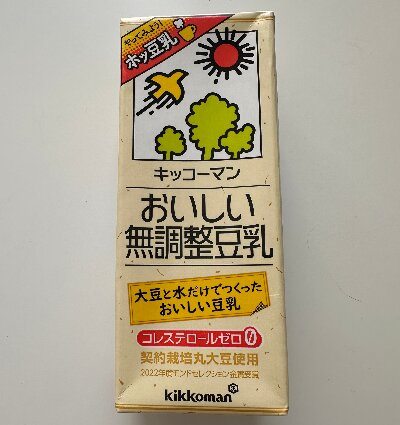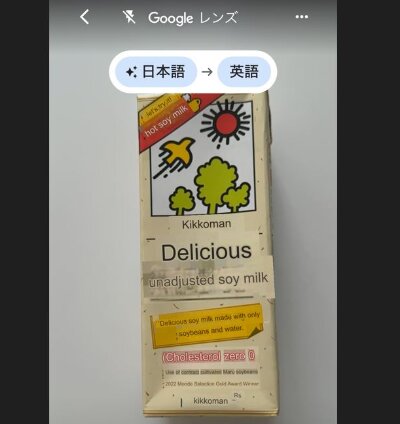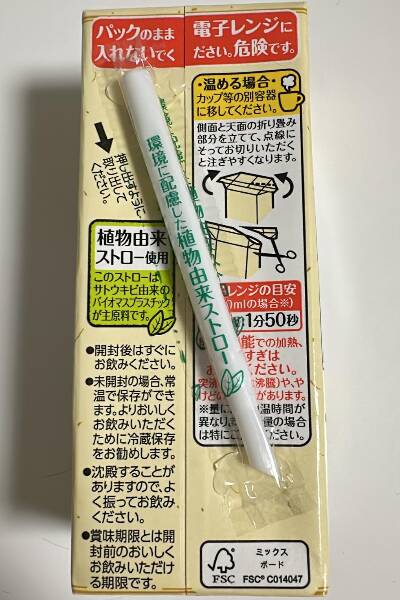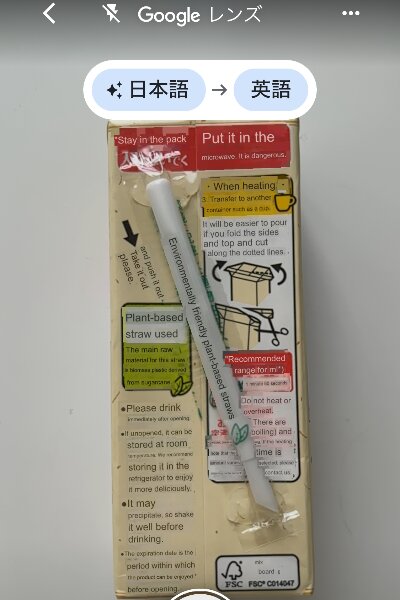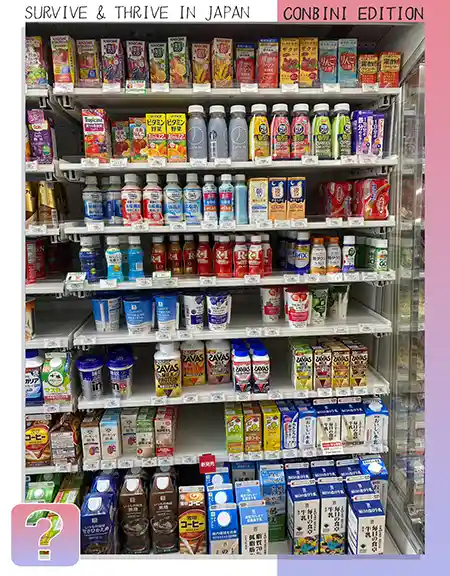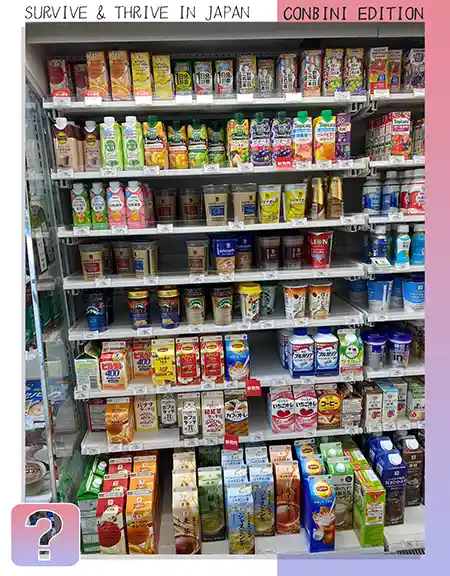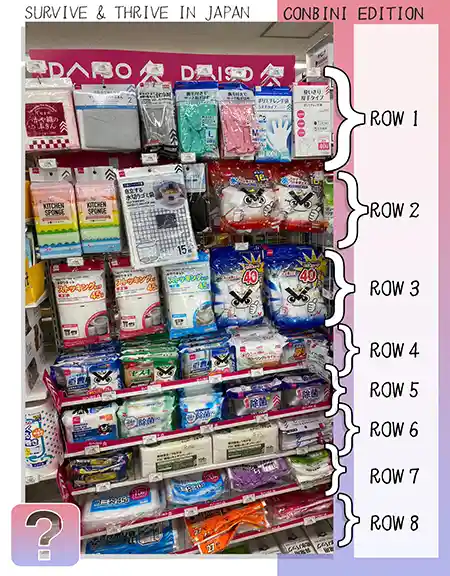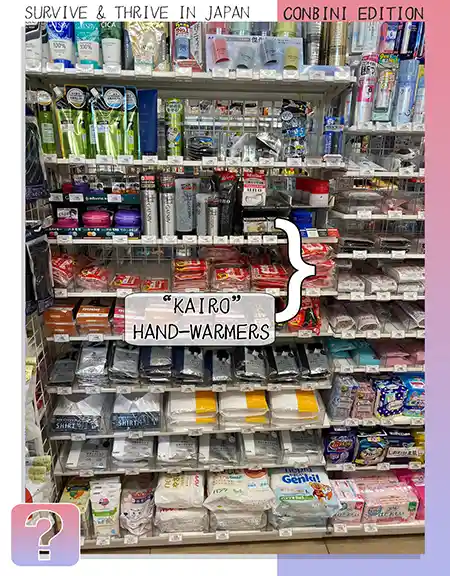Navigating Convenience Stores in Japan:
What You Can Buy in a Conbini
Buy in a Konbini:
Do in a Konbini:
Navigating Convenience Stores in Japan: Buy in a Konbini
Guide 1: Learn to Read Prices and Labels in Japanese Conbini
Welcome to the world of Japanese convenience stores, where delicious snacks and everyday essentials are always within arm's reach!
Reading labels can be a health concern and many of us have special dietary needs; Hypertension? We need low-sodium meals, Diabetes? We need to know the carb count. Bulking up? You’re going to want to know your protein! So, before we dive into that tempting bento box or snack on a strawberry cream sando, let's take a quick look at price tags and labeling in Japan.
Let’s start with pricing:
As of 2024, Japan has two consumption tax rates: 8% for food and drinks, and 10% for everything else, like eating out and alcohol. Confusing, right? Don't worry, you're not alone. Here's the trick:
- Eating in vs. takeout: Even if you order food at a convenience store, if you plan to eat it inside, the tax will be 10%. Take it to go, and it's 8%. Same goes for all takeout from restaurants as well.
- Price tags: Most stores show both the price before tax and the final price with tax included (usually in parentheses). Look for the price in parentheses – that's what you'll actually pay.
| 1) Top left 523: | This is the advertised price with tax. |
|---|---|
| 2) Lower left red 20: | This is the discount you get off the price with tax. |
| 3) Right red 458: | This is the price before tax, after the discount. |
| 4) Right side (503): | This is the final price you’ll pay, with tax included. |
No Price Tags? No Problem
Sometimes, convenience stores ditch the price tags altogether because the price is printed directly on the product label. Don't fret, the same rule applies: prices in parentheses = tax included total cost.
Onigiri Decoded - How to read Onigiri Labels
Let's take a closer look at those tempting rice balls, called onigiri.
| Caption | Means |
|---|---|
| Serving Size: | How many servings are included |
| Product Name: | Just in case you forgot what you're about to devour. |
| Use-By Date (賞費期限): |
Eat it by this date for maximum deliciousness! |
| Ingredients (原材料): |
What's inside your onigiri. |
| Nutritional Information: |
Calories (熱量), protein (タンパク質), fat (脂質), carbohydrates (炭水化物), sugars (糖質), dietary fiber (食物繊維), sodium (食塩) Now you can indulge guilt-free (well, maybe). |
Sandwich Secrets
Similar story for sandwiches: Product name + price with on the front, tax included in the parentheses. On the back, you'll find:
| Caption | Means |
|---|---|
| Product Name: | What kind of sandwich is it? Tuna mayo? Egg salad? The coveted Strawberry Cream? The possibilities are endless. |
| Expiration date (賞費期限): |
Don't wait too long to take a bite! |
| Price excluding tax: | Just for reference, in case you're doing some mental tax math. |
| Tax-included price: | This is the final price you pay, with tax. |
| Storage / Preservation method (保存方法): |
Keep it cool or keep it leave it out, depending on the sandwich. |
| Ingredients (原材料): |
What's in your delicious Japanese Sando. |
| Nutritional Information: |
The same calorie and nutrient breakdown as for the onigiri: Calories (熱量), protein (タンパク質), fat (脂質), carbohydrates (炭水化物), sugars (糖質), dietary fiber (食物繊維), sodium (食塩) |
Navigating Convenience Stores in Japan:
Guide 2: What You Can Buy in a Japanese Conbini
Part 1: Meals
Can’t cook? Don’t have a kitchen? No time? You can still eat like royalty, or at least an adult just using things you’ll be able to buy at a Japanese Conbini.
Sandwiches & Wraps (or “sando” as they’re called here.)
| Row (Left to right) |
Item(s) |
|---|---|
| Row 1: | Burritos |
| Row 2: | Sandwiches (Strawberry cream, fruit mix & cream, milk whip cream, egg, tuna, teriyaki chicken, bacon potato, ham, and chicken cutlet) |
| Row 3: | Tonkatsu Sandwich, 3 types of sando: tuna, ham & lettuce, egg, lettuce, ham & egg |
| Row 4: | Egg Salad Sandwich, Cheeseburger, Breakfast Muffin |
| Row 5: | Chicken Roll, Ham & Cheese Sandwich on a roll, Hot Dog |
| Row 6: | Chinese Fried Rice (classic or with various additions) |
| Row 7: | Japanese flavored rice dishes |
| Row 8: | Omelet Rice, Tianjin Rice (Chinese omelet rice with sweet and sour sauce) |
POINT! If you’d like to start off slowly when it comes to Japanese culinary adventures, or if you have specific foods you can and can’t eat, there’s a lot of food that’s going to feel familiar to you at a surprising quality level available at conbini for fairly low cost and a generally great freshness level. (These aren’t your gas station sandwiches!)
There’s a good line-up of what’s called “Yo-shoku” which means “Western Food” that’s a great twist on favorites from American, European, French, and British menus available if you’d like some comfort food or are getting a little homesick.
Onigiri & Bento Boxes:
| Row (Left to right) |
Item(s) |
|---|---|
| Row 1: | Soups: Spicy, Minestrone, Oden, Japanese Stew, Meat-Wrapped Rice Ball / Onigiri |
| Row 2: | Onigiri with: cod roe, pickled plums (salty ume), salmon, mentaiko (tiny salty fish eggs), tuna mayonnaise, bulgogi (Korean style beef) |
| Row 3: | Onigiri with: sujiko (salmon roe), ume rice, unagil rice, scallop rice |
| Row 4: | Onigiri with: Seaweed rice, fried rice, fried rice, boiled egg, chicken gomoku (bamboo shoots and Japanese veggies) |
| Row 5: | Hand-rolled sushi, salmon sushi, inari sushi (rice in a soy skin) |
| Row 6: | Nori bento (a Japanese staple), Inari set, Onigiri bento, Mini bento |
| Row 7: | Hamburger Bento |
| Rows 8 & 9: | Yakitori-don, Beef Meshi, Oyako-don, Katsudon Chinese bowl, loco moco, beef curry, grilled pork bowl |
A Triangular Meal?
When you need breakfast, lunch, or even a quick dinner to go, onigiri are an easy and healthy option. They come in a huge variety of flavors, and have a special type of wrapping so the nori (seaweed) stays crispy and fresh. (This takes a little skill to learn perfectly, don’t stress it.)
Side Dishes + Salads:
| Row (Left to right) |
Item(s) |
|---|---|
| Row 1: | Hard Boiled Eggs, Onsen Tamago, |
| Row 2: | Potato Salads, Macaroni Salads |
| Row 3: | Pumpkin Salads, Rice Noodle Salads |
| Row 4: | Chinese Salad, Japanese Pickles / Tsukemono, Cooked Spinach with Sesame Dressing, Hijiki Seaweed |
| Row 5: | Kimchi, Napa Cabbage Tsukemono / Japanese Pickles, Cucumber Tsukemono / Japanese Pickles |
| Row 6: | Vegetable Sticks, Mixed Salad, Tuna Corn Salad (Tuna and corn is a popular Japanese combo, it comes on pizza too!), Colorful Salad, Spiced Chicken Salad, Tofu Salad |
| Row 7: | Caesar Salads, Spinach Salad, Shrimp Mayo Salad |
| Rows 8 & 9: | Crab Salad (usually imitation crab), Spinach and Bacon Salad, Choregi Salad (a Korean style salad served at yakiniku restaurants) |
Hearty Bentos:
- Ham cutlet & hamburger bento
- Oyakodon (chicken & egg on rice), katsudon (tonkatsu pork cutlet with egg on rice)
- Loco moco, beef curry, Grilled Pork on Rice
Go for these when you’re extra hungry.
Part 2, Beverages:
Conbini Drinks – How to Choose, What to Watch out For
The number of varieties of canned coffee in Japan, both hot and cold, is famous world-wide. But do you know how to tell the difference between plain water, caffeinated power waters, and sports drinks? Did you know you can buy vinegar for health?
Can you find the right type of milk or soy milk? Do you want a probiotic drink? Beer? Sake?
Here’s what you can expect to find to drink at Japanese convenience stores.
Telling the difference between plain water and sports/vitamin drinks in Japan can be tricky, especially if you're unfamiliar with the packaging and labelling. Here are some tips:
Look for keywords:
- Plain water: Usually labeled with just "水" (mizu) or "ミネラルウォーター" (mineraru wātā) for mineral water. Look for brands like Suntory Natural Water or Evian.
- Sports drinks: Common keywords include "スポーツドリンク" (supōtsu dorinku), "アクエリアス" ( Aquarius = akeruiasu - popular brand), "ポカリスエット" ( Pocari Sweat = pokarisuetto - another popular brand), "イオンウォーター" ( Ion Water = ion wātā).
- Vitamin drinks: Look for "ビタミンドリンク" (bitamin dorinku) or specific vitamin names like "ビタミンC" (bitamin C) or "ビタミンB" (bitamin B). Brands like C.C. Lemon or Lipovitan C are common.
Check the sugar content:
- Plain water will have 0% sugar content.
- Sports drinks usually have around 5-10% sugar content.
- Vitamin drinks can vary, but often have higher sugar content than sports drinks, sometimes exceeding 15%.
Read the nutritional information:
- If in doubt, check the ingredients list and nutritional information on the back of the bottle. Plain water will contain only water and minerals, while sports and vitamin drinks will list additional ingredients like sugars, vitamins, and electrolytes.
Consider the price:
- Plain water is typically cheaper than sports and vitamin drinks.
Other clues:
- Sports drinks sometimes have brightly colored packaging and sporty-looking designs, but the big ones, Pocari Sweat and Aquarius are blue and white and a little tricky, many aren't the lurid colors of sports drinks in the states so beware!
- Vitamin drinks might have specific health claims on the packaging.
- If you're still unsure, ask a store employee or someone who speaks Japanese for help.
Remember, plain water is always the safest choice if you're unsure about what you're drinking. Stay hydrated and enjoy your travels in Japan!
Soy Milk Quest: Finding Lactose-Free Options in Japanese Conbini
Finding lactose-free options in Japan can be challenging, but soy milk is your answer! Luckily, Japanese convenience stores (konbini) are a treasure trove of diverse soy milk options perfect for lactose-intolerant folks. Here's your guide to navigating the aisle:
Step 1: Identify the Soy Milk Section:
- Look for the 冷蔵飲料 (reizou inryō) section, which houses refrigerated drinks.
- Soy milk is usually grouped with other plant-based drinks like almond or oat milk.
Step 2: Decipher the Labels:
- 豆乳 (tōnyū): This literally translates to "bean milk" and is your key term for soy milk.
- 無調整 (muchōsei): This means "unadjusted" and indicates unsweetened soy milk, similar to plain cow's milk.
- 調整 (chōsei): This means "adjusted" and typically signifies sweetened soy milk. Flavors like vanilla, chocolate, and strawberry are common.
- 植物性ミルク (shokubutsusei miruku): This broader term means "plant-based milk" and might include soy milk alongside other options.
Step 3: Look for Lactose-Free Indicators:
- ラクトースフリー (rakutōsufurī): This directly translates to "lactose-free" and is your holy grail.
- 豆乳飲料 (tōnyū inryō): While not explicitly lactose-free, these are often dairy-free and made entirely from soybeans.
Bonus Tips:
- Small size (小 - shō): Opt for smaller sizes to try different options without committing to a large carton.
- Flavored for variety: Explore flavored soy milk options if you prefer sweetness. Just remember, "調整" indicates added sugar.
- Read the ingredients: If unsure, check the ingredients list for "乳製品" (nyūseihin) which means "dairy products." Its absence confirms it's dairy-free.
- Ask for help: Don't hesitate to ask a store employee for assistance if you need help translating or finding specific options.
Soy milk victory! With these tips in hand, you can confidently navigate the konbini aisle and find the perfect lactose-free soy milk to enjoy any time. Remember, konbini are open late, making them a convenient source of relief even after regular grocery stores close. Happy dairy-free exploring!

Stress-free Japanese / Kanji Reading with Google Lens
If you download the FREE Japanese dictionary and install Google lens (also free), you can use your smartphone to read labels, signs, and appliances even off-line!
See the easy steps on our app page:
See Google lens in action:
For your health:
| Item(s) |
|---|
| Tomato juice, vegetable juice, pomegranate juice, apple cider vinegar, black vinegar |
| Fruit juice, apple juice, vitamin vegetable juice, smoothies, drinking yogurt |
| Drinking yogurt / probiotic drinks, Yakult, protein drinks |
| Soy milk, milk, low fat milks |
| Iced coffee, coffee milk (coffee creamer), milk |
Freshly Squeezed & Steamy Options:
| Item(s) |
|---|
| Apple juice, orange juice, pineapple juice, vegetable juice |
| Cocoa, green juice, smoothie, fruit juice |
| Fruit tea, cafe latte, banana au lait, cafe au lait |
| Cafe latte, milk tea, cocoa |
| Coffee, Hojicha tea |
| Lactic acid bacteria drinks (probiotic drinks), lemon tea, apple tea, milk tea, drinking yogurt |
| Apple juice, orange juice, banana latte, cafe latte, black tea latte, cafe au lait, strawberry au lait, coffee milk |
| Apple juice, orange juice, barley tea, green tea, jasmine tea, rooibos tea, milk tea, soy milk |
Part 3, Sundries, 100 Yen Shop Items & More:
From button-down dress shirts to ingenious hand warmers, conbini are stocked for life.
100 Yen Shop Corner:
Some convenience stores even have a 100 yen shop corner like this!
| Row (Left to right) |
Item(s) |
|---|---|
| Row 1: | Dish cloth, dust rag, rubber gloves (different sizes), disposable gloves (different thicknesses) |
| Row 2: | Kitchen sponge, kitchen sink garbage bag (drainage net), gekiochi-kun (like a magic eraser for cleaning, just add water) |
| Row 3: | Kitchen sink (drainage net), mini sized gekiochi-kun (like a magic eraser for cleaning, just add water) |
| Row 4: | Disinfecting wipes, house cleaning wipes (for use on surfaces!) |
| Row 5: | Hand wipes, disinfecting wipes (for use on people!) |
| Row 6: | Kitchen stove cleaner, paper towels (called “kitchen paper” in Japan), garbage bags |
| Row 7+8: | Different types of trash bags |
Essentials for Everyone:Lotion, shaving foam, razors
| Item(s) |
|---|
| Hair wax, hair mousse, hair gel, skin cream |
| Kairo, (Kairo are amazing hand warmers that work for a fe4w hours. Most warm up by shaking the little pouch after you open the outer package, DON’T open the inner package, that’s the “Hokkaido”), women’s tights (most women wear stockings or tights instead of just going bare) |
| Women's socks, foot warmers, stockings |
| Men's socks, trunks, briefs, women's shorts |
| Dress shirts (yes, conbini sell the ubiquitous Y-Shirt (white button up shirt) in case you’ve spilled something and don’t have time to change), T-shirts, napkins |
| T-shirts and napkins |
| Baby powdered milk, baby wet sheets, diapers, sanitary napkins / pads |
Many sell makeup, skin care, and have a nice pampering corner as well.
Navigating Convenience Stores in Japan: Do in a Konbini
Beyond Snacks: The Unexpected Services of Japanese Convenience Stores (Konbini)
Beyond food and basic necessities, Japanese convenience stores (konbini) offer a surprising range of services that go beyond tangible items.

Bill Payments:
- Utilities:Pay for electricity, gas, water, and mobile phone bills.
- Rent: While less common, some konbini allow rent payments (check with your landlord).
- Taxes:Pay national and local taxes through designated terminals.
- Tickets:Purchase tickets for concerts, events, theme parks, and even transportation (local buses, shinkansen)
Financial Services:
- Top-up prepaid cards:Add value to transportation cards, gift cards, and phone cards.
- Cash exchange:Convert foreign currency to Japanese yen (limited amounts).
- Money transfers:Send and receive domestic money transfers through specific services.
Government Services:
- Register for residence cards:Some areas allow initial registration and renewals.
- Pick up official documents: Collect delivered government documents like certificates.
- Apply for public benefits: Submit applications for certain welfare programs.

Other Services:
- Print documents: Copy, scan, and print documents using multi-purpose terminals.
- Ship packages: Drop off pre-labeled packages for domestic and international shipping.
- Rent umbrellas: Borrow and return umbrellas for rainy days.
- Purchase prepaid SIM cards: Get temporary phone connectivity for tourists.
- Use public Wi-Fi:Many konbini offer free Wi-Fi access.
Things to remember:
- Services may vary depending on the konbini chain and location.
- English language support may be limited, so having basic Japanese language skills or a translation app is helpful.
- Cash is the preferred payment method for most services.
So, next time you visit a konbini, remember, it's not just about grabbing a snack! Explore the diverse services offered and make your life in Japan a little easier.
